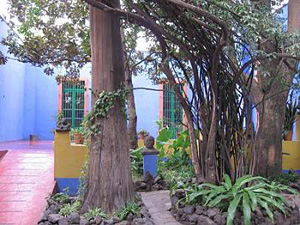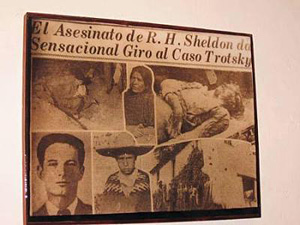Passion, Art and Politics
 Jessica Ravitz - Salt Lake Tribune Jessica Ravitz - Salt Lake Tribune


| | The garden of The Frida Kahlo Museum, in the Coyoacn neighborhood of Mexico City. Known as La Casa Azul, or The Blue House, this is the home where Kahlo was born, lived, worked and died at age 47. (Jessica Ravitz/The Salt Lake Tribune) | 
| | A newspaper tells how Trotsky was attacked with an ice ax by Ramn Mercader, a Soviet agent, on Aug. 20, 1940. He died one day later. |
Mexico City - The spirit of artists Diego Rivera and Frida Kahlo permeates Mexico City's landscape. Even for visitors who are not familiar with the passionate and complex pair, it's difficult to walk the city's streets and visit its landmarks without being touched by their works and their story.

Rivera, who died in 1957 at age 70, was a cubist painter and standout in the muralist movement, which began in the 1920s, after the Mexican Revolution. He imbued his paintings with his Marxist beliefs, love for Mexican heritage and respect for common laborers the world over.

Twenty years younger than Rivera, Kahlo was a self-taught painter who developed her craft while recuperating from a body-shattering bus accident that left her permanently disabled. Her work, dominated by self-portraits, was often a testament to her emotional and physical suffering.

The two met when he was painting a fresco at the National Preparatory School, where she was a student, and reconnected years later, marrying in 1929. For the next 25 years, the couple had a tempestuous relationship marked by adultery on both sides, rumors of domestic violence and an undying love that - as evidenced by a short-lived divorce - couldn't keep them apart. They were together until her death in 1954, at age 47.

The works, and images of the couple, dot museums and gift shops across the country. But in one day only, a Mexico City tourist can drink the story in.

Start at the Palacio Nacional, at the east side of the Plaza de la Constitución (or Zócalo, to locals), which is the heart of the capital city. The area, which spans some 34 blocks, combines sites from ancient ruins to modern-day structures, and everything in between. The people who fill the plaza and surrounding streets also represent a span in time. The cosmopolitan, for example, line up for spiritual cleansings by people in traditional Aztec clothing.

Surrounding a large courtyard in the National Palace, Rivera murals painted between 1929 and 1951 chronicle Mexican civilization from the arrival of Aztec deity Quetzalcoatl to the social and cultural movements of the 19th and 20th centuries. Each mural tells a story, and to study them is to journey through history, with Rivera serving as tour guide.

About six miles from downtown, in a colonial-era neighborhood called Coyoacán, the home where Kahlo was born, worked and eventually died sees a steady flow of visitors. Splashed in bright colors, Casa Azul - or the Blue House - is filled with mementos treasured by the passionate couple, as well as artwork and belongings (including a diary) showcasing Kahlo's skill and tortured existence. An audio tour of the museum offers explanations of the autobiographical images, such as paintings depicting her broken heart, references to her miscarriage and the pain she felt for never bearing a child.

The bedroom, which holds her deathbed, overlooks the rich and inspired garden Kahlo treasured. Another bedroom holds her childhood memories, including toys she loved and the butterflies she collected with her father. In a nearby studio, a wheelchair sits in front of an unfinished portrait of Josef Stalin.

Politics were important to Rivera and Kahlo and prevalent in their paintings. For example, Rivera's refusal to keep Vladimir Lenin out of "Man at the Crossroads," a mural commissioned for New York City's Rockefeller Center, led to the mural's destruction. And Kahlo's piece "Marxism Will Give Health" depicts the young, disabled artist throwing her crutches to the side.

A short walk from the Frida Kahlo Museum is the home-turned-museum of Leon Trotsky, the Soviet revolutionary who gained political asylum in Mexico after his opposition to Stalin's policies in the 1920s led to his expulsion from the Communist Party and exile from the Soviet Union. The modest and dank home, with steel doors and watch towers, was where Trotsky was assassinated by a Soviet agent in 1940.

Photos in the museum include Rivera and Kahlo, who welcomed Trotsky to the country in 1937. For two years, in fact, Trotsky and his wife, Natalia Sedova, lived in the Blue House. A falling-out with Rivera spurred Trotsky's move; whether this was a result of an affair between Trotsky and Kahlo is unclear.

A bullet-riddled bedroom wall is a remnant from a first assassination attempt, three months before Trotsky was killed. Framed newspaper clippings in the museum recount his actual death. Ramón Mercader - a Soviet agent who ingratiated himself by becoming the boyfriend of Trotsky's assistant's sister - entered Trotsky's office to show him an article, and while Trotsky read, Mercader lodged an ice ax in the revolutionary's head.

An outdoor courtyard has a memorial to Trotsky and his wife, a Soviet pair who found a resting place in a world far away from their home. Though they were welcomed with open arms by Rivera and Kahlo, Trotsky's death came during his rift from the two. As a result, both artists were initially investigated after Trotsky's murder, although charges never were filed against them.

From Trotsky's home and memorial, visitors can stroll along the quiet, tree-lined streets of Coyoacán toward Plaza Hidalgo. There they can sit down at a cafe and absorb the history, the passion, the art and the politics reaped in one day of touring.

jravitz@sltrib.com

A visit to Mexico City

GETTING AROUND

* Precautions should be taken when traveling by taxi in Mexico City. Tourists are advised to not flag down a cab. Instead, phone for one or walk to kiosks marked sitio, where radio taxi service cars await.

WHERE TO GO

* The Plaza de la Constitución, or the Zócalo, includes numerous sites worth visiting, including the Metropolitan Cathedral and the Templo Mayor, or the Main Temple, a site dating back to the Aztecs. Visitors can view murals painted by Diego Rivera at The National Palace, where admission is free. At the Zócalo, be sure to take in the surroundings, including the street performers, spiritual blessings and outdoor markets.

* Coyoacán is six miles south of downtown Mexico City. It was once considered an outlying town until urban sprawl made it part of the larger city. But the neighborhood still has a colonial-era feel. The Blue House, or Frida Kahlo Museum, is six blocks north of Plaza Hidalgo at Londres 247 Col. Del Carmen. The museum is closed Monday. There are a nominal cost for entry (about $3 for adults) and an additional fee for the audio tour. Both expenses are well worth it.

* A short walk away, at Av. Rio Churubusco 410, tourists can enter the Leon Trotsky home and museum. This site is closed Monday. Admission is about $3.

* At Plaza Hidalgo in Coyoacán, you can enjoy live musical performances, craft markets and a plethora of cafes.

INFORMATION

* For tips on travel in Mexico, visit www.mexonline.com.

* Biographies about Frida Kahlo and Diego Rivera are available at, respectively, www.mexonline.com/fridakahlo.htm and www.mexonline.com/diegorivera.htm. |



